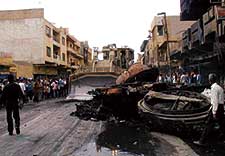 |
| HEAVYWEIGHT Armored D9 dozer clears remains of Iraqi tank in An Najaf on June 13. (Photo courtesy of the 101st Airborne Division) |
The war in Iraq redefined the role of the military engineer, both in combat and in reconstruction. It tested an evolving U.S. military doctrine of rapid deployment that leans heavily on engineers. The campaign was remarkable, with implications that will be studied and acted upon for years.
Now that the major battles are over and reconstruction has begun, engineer commanders are assessing their roles and strategies. The main engineer commanders during the invasion were Col. Gregg Martin, head of the Armys 130th Engineer Brigade and chief engineer for V Corps, and U.S. Navy Rear Admiral Charles (Chuck) Kubic, commander of the 1st Marine Expeditionary Force Engineer Group, and the Naval Marine Construction Battalions (Seabees). In responses to e-mailed questions, interviews, and in the case of Martin a paper to be published in Engineer, the Armys professional bulletin, they suggest:
- Expanding, upgrading and updating the engineers equipment fleet and providing engineers with dedicated long-haul capability to move their own material, equipment and gear.
- Providing high-bandwidth communications systems for engineer units that are robust enough to handle digital photos and drawings and giving engineer transmissions a high priority.
- Widely deploying compact, tele-engineering equipment kits that let field units consult directly with experts in the U.S. via satellite.
- Moving supplies and construction materials forward earlier and deploying prefabricated materials such as modular mats for helicopter pads.
- Having engineers work more closely with explosives ordnance disposal teams to clear weapons caches and ammunition dumps in order to improve safety and security.
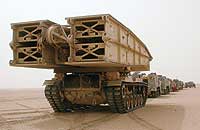 |
| UNDERSIZED Automatic Vehicle Launched Bridge, poised to invade, March 20. (Photo by Tom Sawyer for ENR) |
The commanders also are drawing lessons from the reconstruction, although they say it is premature to come to many final conclusions. However, they observe that military engineers have become increasingly involved in hundreds of local civic projects to improve local relations and restore services and order. But they say they could have done many more such projects and delivered them faster if they had known in advance the volume of work facing them.
Kubic says the Seabees are now all out of Iraq but could have used more money while there to engage local contractors. "I was a bit disappointed by the slow start of major civilian reconstruction...and found my Civilian/Military Operation efforts significantly constrained by our inability to receive any funding appropriated for this purpose, despite extensive project assessments and discussions with all the responsible agencies," Kubic says.
"Given the critical importance of CMO during the recovery phase...we began to use funds seized from the former regimemostly new $100 billsto buy construction materials in Iraq and Kuwait and to hire Iraqi workers, and ultimately Iraqi contractors, to get on with reconstruction," Kubic says.
Martin also turned to seized funds to jump-start local reconstruction with neighborhood projects engaging local workers with army engineers. Lt. Gen. William Wallace, former commander of V Corps, conceived of the Task Force Neighborhood program when humanitarian reconstruction efforts failed to fill in quickly (ENR 6/9 p. 16).
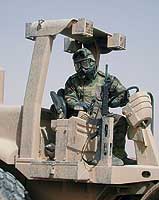 |
| READY Soldiers work through missile alerts. (Photo by Tom Sawyer for ENR) |
"It was originally conceived that the Office of Reconstruction and Humanitarian Assistance would come and do a lot of work with the Iraqis. But its a much tougher, more complicated thing," Martin says. "Out of necessity, the Army jumped in and got involved with a lot of things we didnt expect we would."
The Seabees "accomplished a lot with the money we were able to obtain," says Kubic. "But we clearly could have done at least 10 times more if we had proper and sufficient CMO funding in place right as Baghdad fell."
In less than four months, the Seabees completed 158 construction projects valued at more than $7 million, Kubic says. "The silver lining was that we quickly found very capable Iraqi small business contractors who were ready, willing and able to submit fixed-price bids for our projects and to complete the work quickly with good quality workmanship. As the U.S. construction contracting effort began to engage in the south in late July, our local Iraqi contractors were back in business and ready to serve as prime or subcontractors," Kubic says.
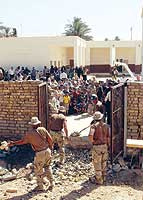 |
| BUILDERS Navy Seabees clear an entrance to a new playground at a school on May 24th. (Photo courtesy of the U.S. Navy/Arlo K. Abrahamson) |
The militarys active role in reconstruction has not been seen at this level since World War II. Kubic says forces rebuilding Germany were in much less of a public spotlight. "I cant help but feel the U.S. government and its military forces had more of a free hand after WW II with less global visibility and certainly less daily media coverage of each and every minor setback on the road to recovery," he says. Few people now recall that guerrilla action against allied occupation forces continued well into 1947, he says.
"The Army has been some form of nation builder for over two centuries," says Henry G. Hatch, former chief of the Corps of Engineers during the first Gulf War and now a private consultant.
Kubic and Martin both say engineers need to be trained, equipped and supplied to aggressively conduct civil works projects on a large scale as soon as hostilities ebb, and they need to be prepared to continue them for many months, if necessary.
 |
| BRIDGING Support went on around the clock. (Photo courtesy of the U.S. Navy/Jacob A. Johnson) |
But downsizing over the last few decades has reduced the size of the military by about a third, much of it tasking out work formerly done by soldiers to private contractors. "Engineers are critical to both war-fighting, peacemaking and stability and support operations. Theyre critical for the whole deal," says Martin. "People had a theory that we can do without these units and replace them with contractors. Where are you going to get contractors to do what these guys have done? These guys are critical."
Both Kubic and Martin say there are limits on how far outsourcing to contractors should go. Kubic says military engineers need a "proper blend" of both troop and contractor logistics capability, but that troops must be prepared at any moment to pick up if civilian support falters. "I saw very good contractor support and very poor contractor support before, during and after the war," Kubic says. "In all cases, the support was quite expensive and was often quickly overwhelmed by spike loading of service/support requirements."
In some instances the contractors showed battle nerves. When an Iraqi-launched Chinese Searsucker cruise missile landed less than 200 yd from Kubics command tent at Camp Commando in northern Kuwait, "I saw panicked contractors bailing out as quickly as their legs and SUVs could get their backsides out of town," says Kubic. "It was good we didnt rely totally on their support."
| RECONSTRUCTION
Few people are in a better position to evaluate the Iraqi reconstruction challenges than Basil Sabbah, the CEO of Baghdad-based Sabbah Brothers Corp. Today, his cousin Saeed heads operations from Baghdad as company president while Basil looks for reconstruction opportunities from a U.S. office. Security remains the paramount concern, says Basil. "No one wants to be seen in Iraq as a collaborator, so people are reluctant to even be seen talking to the U.S. military," he says. The 35-year-old Denver resident was born in Baghad. His mother is American; his father Iraqi. They met while both were students at the University of Michigan. The couple moved to Iraq, where Mohammed Sabbah and his brothers Ali and Abdul Rahman founded Sabbah Brothers, or Sabbro, an engineering and construction firm. The brothers prospered during the 1960s and 1970s, working as a subcontractor for Iraqs national oil companies and multinational firms such as Lurgi, Thyssen, Cruesot-Loire and Mitsubishi. By 1978, the firms work on oilfield infrastructure, chemical plants and transportation projects had elevated it to the largest construction and personnel outsourcing company in Iraq, according to the company Website www.sabbro.com. But Saddams wars against Iran and Kuwait began an abrupt reversal of fortune. Sanctions after the Gulf War ended multinational participation in Iraqs economy. Sabbros payroll shrank from more than 800 employees in 1978 to less than 50 earlier this year. Basil Sabbah moved from Iraq to California at age 13. After earning degrees in physics and anthropology from the University of California at Santa Barbara, he worked for Halliburton, Schlumberger and Network Appliance, but always kept in touch with Saeed as he moved up through the family business. Basil came aboard this year. The firm has been gradually adding staff and rebuilding its portfolio since the war ended. Oilfield infrastructure work in southern Iraq topped the list. This week, Sabbro landed work on the Baghdad Sheraton rehabilitation. Rebuilding Iraq is a huge challenge, Sabbah notes. "Few engineers have worked with AutoCAD, for example, and then only in 2-D. Were looking for long-term partnerships with firms willing to transfer technology to Iraqis. Thats the only way it can work." |
Houston-based KBR, the principal support contractor for the Dept. of Defense in the theater, declined comment for this article.
The mission of the engineers during an invasion is to assure the forces mobility by conjuring an infrastructure to support, sustain and protect the advance as it races across enemy territory, say the commanders. They explain that the concept of "assured mobility" is at the heart of the Defense Dept.s evolving ground warfare doctrine. The philosophy puts the impetus on lean, hard-charging mechanized infantry and armored units racing deep into enemy territory, executing high-intensity warfare under close air support.
To sustain such an assault, mobility must be assured by engineers aggressively clearing obstructions, sometimes under fire, and creating supply conduits while simultaneously throwing up protection around supply areas and tactical bases used for launching attacks. The work must be performed at a quick pace across a vast swath of disputed territory.
This is exactly what happened during the Iraq invasion. "For the first time in history, Seabees joined the Marine Expeditionary Force order of battle and attacked in regimental formation," Kubic says. "The engineers are all over the battlefield," said Wallace, then commander of the ground campaign, in an interview on April 11 as he met with engineers to assess battle damage at Baghdad International Airport. "Theyve done everything....Not only are they flexible, but they are immensely proactive. They look for solutions, rather than problems."
Engineers suffuse the forces with soldiers and marines trained in engineering skills in every combat squad. They resolve immediate problems, such as clearing fields of fire and setting up gun emplacements and fighting positions.
But at a higher level, the U.S. Army Corps of Engineers and the Seabees in the Marines Corps each have specialized units that are equipped and trained to tackle larger engineering objectives, such as road and bridge construction and runway repairs.
Reservist Zachary Semsick of Blairsville, Pa., an engineer with the 458th Engineer Battalion, is a prime example. He deployed to Kuwait in November and was attached to six different units from the time the invasion launched on March 21, until he returned home Aug. 24. "They used us," he says. "We traveled a lot, from Kuwait almost up to the Turkish border and back."
Although trained for mine clearing, reconnaissance and wire obstacle placement and removal, Semsick said most of his missions were with bridge companies. He trained on the job.
| ORDNANCE
The amount of ordnance and weaponry spread across Iraq almost defies description. It has been widely reported that Saddam Hussein spent practically nothing on Iraqs infrastructure once he went to war with Iran in the 1980s. What is equally evident is how much money was funneled into armamentAK-47s, rocket-propelled grenades, mortars and land mines carpet the country from one end to the other. There now is a public safety problem of immense proportions as the lethal mix includes unexploded cluster bombs that U.S. aircraft sprinkled across the countryside. The challenge is to protect civilians and military and at the same time keep weapons from falling into the wrong hands. The U.S. Dept. of Defense has decided that ordnance control should be transferred from military teams to private contractors (ENR 9/1 p. 9). The U.S. Army Corps of Engineers is administering the program through existing contracts issued by its Huntsville, Ala., office. "The Corps is saying that this isnt work for combat troops," says Frank DeMartino, president of Parsons Corp. "Rather than make it a core activity, theyll put it in the civilian sector." The Pasadena, Calif.-based firm is handling logistical work, site acquisition, housing and transportation on the $287-million project. Tetra Tech FW, Pasadena, one of three firms responsible for ordnance removal, segregation and transportation, "will have in excess of 100 people on the ground," says Sam W. Box, president of the firm. |
Martin, who is still in the field, and Kubic both praise the performance, skills and organization of their troops. But both found room for improvement. They say combat engineers need a faster, more powerful fleet of tactical construction equipment, dedicated haul vehicles and armored personnel carriers. They need to match the speed and toughness of the tanks and Bradley fighting vehicles used by the troops they support, the commanders say. With the major exception of 16 new armored D9 Caterpillar bulldozers, fielded for the first time in Iraq with great success, the engineers tactical construction equipment and personnel carriers are old, says Martin. Some machines were in the field before the Vietnam War. For decades, budget tightening has shorted engineers on equipment and upgrades, both Martin and Wallace say.
Both cite the automatic vehicle launched bridge (AVLB) built by General Dynamics Land Systems, Sterling Heights, Mich., as a prime example. It is a folding bridge built on an M60 or M48 tank body. Its maximum speed is 30 mph on the road, 8 to 12 mph on open terrain. It can bridge an 18-meter gap, but because it is not sized to support the current M1 Abrams tanks, can only bear them across a 15-meter span, with caution. Improvements have been engineered to upgrade it to Abrams compatibility, but they have not been funded.
A significantly improved, 24-meter replacement, the Wolverine, has been in development since 1983 and is available. But Congress repeatedly has delayed acquisition, citing budget cuts. Only a handful have been purchased and fielded.
But most worrisome to Martin are the engineers older-generation armored personnel carriers. They are slower and more vulnerable than the Bradleys used by the units that the combat engineers often support.
"Our tactical construction equipment is old," Wallace observed back in April. "Weve had any number of programs that have been in the works for years get canceled because of funding shortages."
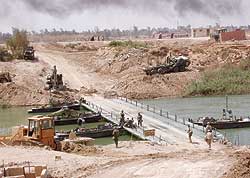 |
| CRITICAL ASSET River craft hold float bridge near Baghdad on Diyalah River in April. (Photo by Andrew G. Wright for ENR) |
A spokesman for Caterpillar, which supplies a great deal of the engineers equipment, says that the age of equipment does not mean it is in poor repair. The military has extended service contracts for construction equipment and machines are dismantled down to the frame and completely rebuilt, extending their life by two or three times. Caterpillar currently is gearing up its dealers in the Persian Gulf region to perform the work locally.
Martin says engineers were tested hard and they are trying to learn their lessons well to prepare for future engagements. "We are really doing our best to make sure we are ready," he says.
| Military Equipment | |
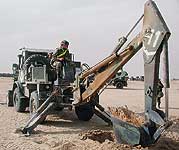 |
SEE Truck Freightliner SEE (Small Emplacement Excavator) is lightweight but quick to the action. It has a small bucket on the front and hoe on the back, with an arm that lays over to drop the center of gravity for travel. Its handy for chasing troops and digging them in. |
|
D9 Dozer Army engineers says the armored Caterpillar giant is worth its weight in gold. Particularly suited for urban warfare, its 70 tons and power are well-suited to knock aside heavy obstacles, while armor protects operators in the cab and hydraulics. | 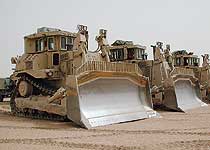 |
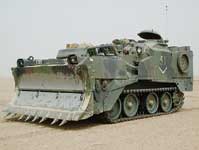 |
M9 ACE Armored Combat Earthmover, built by BMY Combat Systems, can do 30 miles per hour on road and be transported by C-130 aircraft. A unique suspension system lets the front be raised, lowered or tilted for dozing, excavating, rough grading and ditching. |
|
563D Vibratory Roller Caterpillar rollers for road and runway construction are found in combat support and construction units. Such noncombat units often have many female soldiers. This runway project near An Najif in April was broken into three parts, all under the direction of women. officers. | 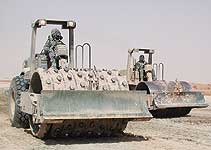 |
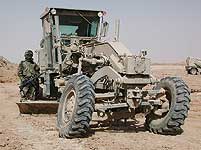 |
Cat 130G Motor Grader Supply routes are lifelines during assaults, but in Iraq routes were shifted from highways to desert tracks when counterattacks began. Engineers had a shock load of work. Operators routinely worked through gas and missile alerts to keep convoys moving. |
|
Cat d7G dozer Workhorses of the invasion, and now of reconstruction, D7s were heavily used to push up miles of berms to surround camps and other facilities for force protection. Berming begins whenever units pause to bed down and is repeated again and again as they move. | 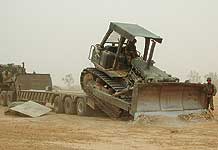 |



Post a comment to this article
Report Abusive Comment